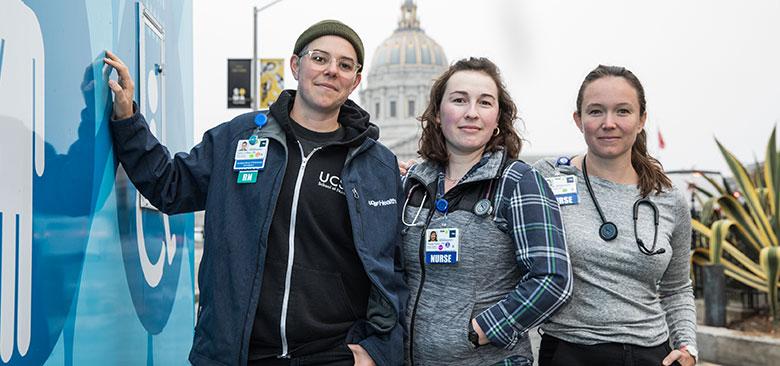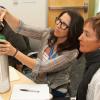
Top 10 Most Read Stories in 2019
Understanding the link between stress, depression and the microbiome, addressing California’s primary care gap and mental health needs, and planning for the long-term health care of aging baby boomers were among the most-read Science of Caring stories this year.
Here’s a look back at our most popular stories in 2019.
1. What Does the Microbiome Have to Do with Stress and Depression?
 An innovative new study seeks to establish and characterize the connection among stress, depression and the microbiome.
An innovative new study seeks to establish and characterize the connection among stress, depression and the microbiome.
Professor Sandra Weiss at the UCSF School of Nursing and her team are collecting data from 150 babies during their first two to three weeks of life, and at the 6- and 12-month marks, to determine if maternal depression, stress and/or corticosteroid exposure during pregnancy are connected with the proliferation or depletion of specific microbiota and any imbalance in beneficial versus pathogenic bacteria. The preliminary analysis has already elicited some fascinating findings.
“The microbiome of babies whose mothers are depressed during pregnancy is depleted of many important bacteria that may have beneficial effects for the infant’s well-being,” Weiss said. “We found similar effects for infants whose mothers had received corticosteroids during pregnancy.”
2. Taking Nursing to the Streets in Homeless Outreach
At San Francisco’s Civic Center, a team of UCSF nursing students are delivering “bridge” care to people experiencing homelessness, offering nursing advice to a population that is often wary of visiting  hospitals or clinics.
hospitals or clinics.
“We build rapport with clients by letting them know we care about them and that they can be honest about their health problems,” said student Janelle Silvis.
To help their peers understand the needs of people experiencing homelessness, the group is developing a “street nursing” elective, with support from School leadership and faculty. Meanwhile, faculty have formed a workgroup to develop and secure funding for a new research project addressing homelessness.
3. Nurse Practitioners Can Help Close California’s Primary Care Gap, But It Won’t Be Easy
 California's shortage of primary care providers has reached alarming levels, especially in rural areas. Nurse practitioners can help close that gap.
California's shortage of primary care providers has reached alarming levels, especially in rural areas. Nurse practitioners can help close that gap.
Expanding education programs in underserved areas, increasing the diversity of the NP workforce and ensuring that NPs feel empowered are key to meeting these primary care needs, say UCSF School of Nursing faculty members Joanne Spetz and Ulrike Muench.
From conducting research that provides the evidence base for policymakers to training students, faculty and preceptors, this story takes a look at how the School is working to help fill the gap.
4. Novel IPE Partnership Aims to Expand Access to Mental Health Care
To tackle the severe shortage of mental health professionals in California, a new interprofessional partnership aims to accelerate and enhance the training of a new generation of mental health experts. 
The Dyad project – led by the School of Nursing’s Chelsea Landolin and the School of Pharmacy’s Patrick Finley – is preparing nurse practitioners and clinical psychiatric pharmacists to provide needed mental health services and to understand how to work as part of a team.
5. The Time is Now for Precision Patient Monitoring
 Advances in machine learning, the increasingly sophisticated ability to read and translate signals from the body and the widespread adoption of electronic health records (EHRs) have created an unprecedented opportunity to make the vision of precision patient monitoring a reality.
Advances in machine learning, the increasingly sophisticated ability to read and translate signals from the body and the widespread adoption of electronic health records (EHRs) have created an unprecedented opportunity to make the vision of precision patient monitoring a reality.
School of Nursing faculty members Xiao Hu and Michele Pelter outline what is needed to develop the next generation of patient monitors aimed at reducing alarm fatigue and predicting life-threatening events before they happen.
6. A New Look at an Old Model: Psychedelic Drugs and Patient Care
Once considered “career suicide,” research into psychedelic substances is experiencing a renaissance. In a new “breakthrough” study, School of Nursing associate professor Andrew Penn is exploring the  effectiveness of psychedelics in treating post-traumatic stress disorder.
effectiveness of psychedelics in treating post-traumatic stress disorder.
When administered in a controlled setting, Penn said one banned drug can quiet parts of the brain associated with fear or threats, allowing patients to open up about traumatic events.
7. Nurse-Researchers Instrumental in Planning for the “Silver Tsunami”
 By 2030, the number of people over the age of 65 will nearly double as a result of aging baby boomers and demands for health care will mount. Yet a shortage of long-term care workers will affect their ability to access skilled care.
By 2030, the number of people over the age of 65 will nearly double as a result of aging baby boomers and demands for health care will mount. Yet a shortage of long-term care workers will affect their ability to access skilled care.
School of Nursing faculty researchers are engaged in a variety of projects to examine this workforce issue. These include new technology-based solutions, analyzing the strengths and weaknesses of home care and nursing scope-of-practice laws to provide guidance to policymakers, and delving into data to better understand and predict caregiver shortages.
8. How Unstable Work Schedules Affect Individuals and Families
What happens when people get their work schedules just a few days in advance or have their shifts changed or cancelled at the last minute? 
“If you think you’re going to work, there’s a certain amount of emotional energy that goes into getting on your uniform, getting to the job. And sometimes you show up and your shift gets canceled,” said Kristen Harknett, associate professor at the School of Nursing.
The Shift Project, led by Harknett and UC Berkeley’s Daniel Schneider, has collected data from more than 30,000 workers in 120 large retail and food service businesses in the U.S. to enhance our understanding of the impact of unstable work schedules on workers — and to inform labor policy.
9. Combating Childhood Obesity in East Oakland
 The percentage of youth affected by obesity has more than tripled since the 1970s. According to the National Center for Health Statistics, 18.5 percent of those ages 2 to 19 qualify as obese.
The percentage of youth affected by obesity has more than tripled since the 1970s. According to the National Center for Health Statistics, 18.5 percent of those ages 2 to 19 qualify as obese.
To combat obesity, professor emeritus Naomi Schapiro led a project to design and test a group intervention model at three underserved East Oakland middle schools — with promising results. The six- to 10-week intervention showed “a significant decrease in soda consumption, increased support from classmates, and an increased number of exercise days.”
10. Understanding the Irreplaceable Role of Mom-and-Pop Spaces for Aging Adults: A Conversation with Stacy Torres
Assistant professor Stacy Torres is shedding light on the significance of long-standing mom-and-pop places to the daily routines of older adults who regularly gather in these spots. 
As these mom-and-pop establishments are increasingly threatened by gentrification, she’s examined the impact on people when they tried to find an alternate location.
“It was challenging for them because they were never able to exactly re-create the conditions they found in the little bakery, which had become a de facto senior center for people who didn’t want to go to senior centers,” Torres said. “It was important for them to get out of the house and have some social contact, but they didn’t want to be in a space that was set aside just for people over 65.”



